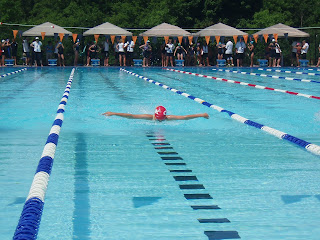Un entrenamiento aguado para el Kilimanjaro // A wet training for Kilimanjaro
Uno de
los retos que tenemos para entrenarnos para subir al Kilimanjaro, es que la
ciudad es bastante plana. No es fácil conseguir pendientes pronunciadas y las
que hay suelen ser bastante cortas, con lo cual toca el tedioso ejercicio de
subir y bajar un montón de veces. Confieso que solo me he dedicado a esa rutina
una sola vez. Aunque parezca arriesgado nuestro entrenamiento ha sido
esencialmente plano. Tan plano que la mayoría ha ocurrido en la piscina.
Rodrigo
y Marcela prácticamente no han modificado su rutina de ejercicio. Rodrigo
estaba nadando hasta la semana pasada 6 veces por semana, y es quizás el mejor
preparado físicamente, mientras que Marcela nadaba 4 veces por semana. Ambos
habían añadido a sus prácticas de natación unas pocas caminatas largas, algún
que otro paseo en bicicleta y muy pocos trotes.
Mi
entrenamiento también ha sido mayoritariamente en la piscina: 3 días de
natación a la semana más otros dos (o tres en algunas semanas excepcionales) de
trote. Cuando nado, suelo cubrir entre 2.5 y 3Km y cuando corro cubro entre 5 y
10Km. Completo el entrenamiento con ejercicios para fortalecer los lumbares por
miedo a que me venga un lumbago en pleno viaje.
La
única que no ha apostado a la piscina es Federica que tiene una rutina de
preparación principalmente seca: clases de aeróbicos, algunas caminatas,
algunas corridas y últimamente dos días de bicicleta a la semana.
 ¿Servirá
éste plan de entrenamiento para alcanzar la cumbre? Pronto lo veremos. Según
hemos leído estar en buena forma física no garantiza llegar a la cima. El mal
de altura constituye la principal causa por la que las personas no pueden
alcanzar la cumbre del Kilimanjaro y para ello no hay entrenamiento que valga.
¿Servirá
éste plan de entrenamiento para alcanzar la cumbre? Pronto lo veremos. Según
hemos leído estar en buena forma física no garantiza llegar a la cima. El mal
de altura constituye la principal causa por la que las personas no pueden
alcanzar la cumbre del Kilimanjaro y para ello no hay entrenamiento que valga.
As the city were we live is fairly flat, training to climb
Kilimanjaro is a challenge. It is not easy to find a decent hill (less a
mountain!) and the existing ones are usually quite short, which means that if
you want to do a long steep distance you get trapped in the tedious exercise of
going up and down a small one, several times. I confess that I have done this
routine only once. It is maybe risky, but our training has been essentially
flat…so flat that most of the time we´ve been training in the swimming pool.
Rodrigo and Marcela practically have not changed their
exercise routine. Rodrigo was swimming 6 times a week till just some days ago,
and he is perhaps the best physically fitted of the four of us. Marcela is the next one, she swam 4 times a
week. Both had added to their swimming practices a few long walks, occasional
bike rides and some running.
My training has also been mostly in the pool: swimming three
days a week, other two (or three in some exceptional weeks) for running. When I
swim, I usually cover between 2.5 and 3Km and when I run I cover between 5 and
10Km. To complete my training, I added some core exercises to strengthen mainly
the lower back. I am terrified of having a low back pain in the trip.
The only one who has not opted for the swimming pool is
Federica. She is having a mainly dry preparation routine: aerobic classes, some
walking, some runs and lately she is biking twice a week to her work.
Will this workout plan serve us well to reach the summit?
Soon we'll see. As we have read, to be in good physical shape doesn’t mean that
you will reach the summit. Altitude sickness is the main reason why people
cannot climb to the top of Kilimanjaro. Unfortunately, there is no training for
preparing you for the altitude.



Comments